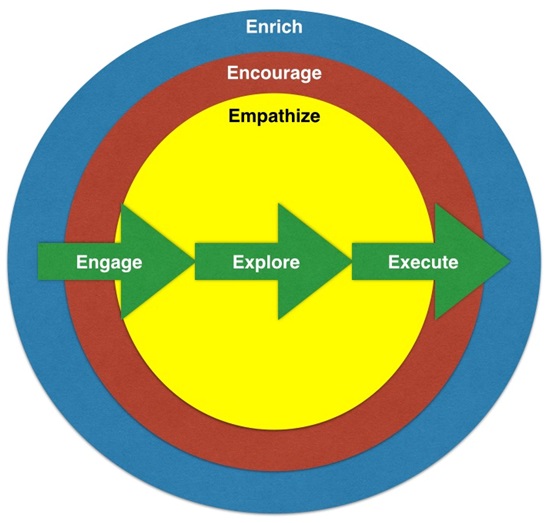A Coaching Model Created by Kimberly Denise Dennis
(Life Coach, UNITED STATES )
The Coaching With E’s (Ease) Coaching Model focuses two elements of coaching: the Evolution of the process and the Environment of the process. The components of each element are presented the figure and described in detail below.
 The Evolution of the Coaching Process
The Evolution of the Coaching Process
The coaching process grows and changes throughout the conversation. This evolution consists of three phases:
Engage
The coaching process begins by engaging the client. Engagement includes establishing a rapport with the client as well as establishing the goals for the coaching session. The goals are simply a starting point for the conversation. This is also the time to identify the ideal state and to clarify how that differs from the status quo.
Questions:
Explore
This is the most exciting phase! Client and coach work together to delve into the client’s goals, challenges, obstacles, wins, and next steps. The conversation follows the ebb and flow of the client’s needs. It is an exchange of questions, ideas, and possibilities.
Questions:
Execute
And now it is time for action. Much of this takes place outside the coaching process. The coach inquires about best next steps, the client identifies and commits to a series of actions, and together they reality test the commitment and discuss possible roadblocks, and any needed support structures. The client then carries out the actions and prepares to discuss his or her progress at the next coaching session.
Questions:
The Environment of the Coaching Process
The coaching process exists within an environment of empathy, encouragement, and enrichment. It is the coach’s role to create this supportive environment for the client.
Empathize
Throughout the process, the coach must empathize with the client. Empathy is the ability to experience the client’s emotions and point of view. This can only occur when the coach is listening actively to what the client has to say. Active listening is non-judgmental, free from guilt, and without shame.
Encourage
The coach also creates an environment of encouragement. The coach serves not only as cheerleader, but also as a sounding board, motivator, and supporter.
Enrich
Finally, the coach also creates an enriching environment. Coaching is a transformational process—clients come to coaching because they want to make a personal or professional change. The coaching progress must enrich the client’s life through this transformational process, leading to an improvement in their quality of life. The coach accomplishes this by helping the client keep his/her primary goal in focus while exploring the “whole person.” The coach also checks in with the client periodically to confirm that the coaching process is beneficial to the client.
Conclusion
The Coaching with E’s Model describes a coaching evolution and environment leading to a supportive, transformational relationship between coach and client.